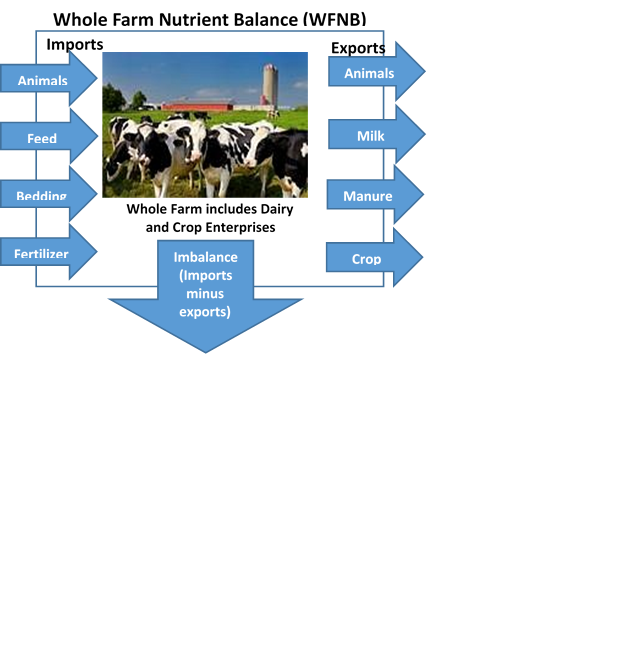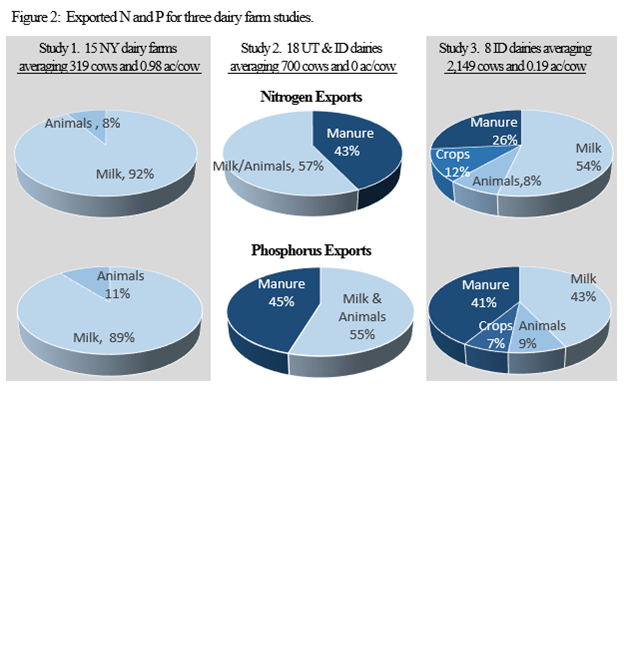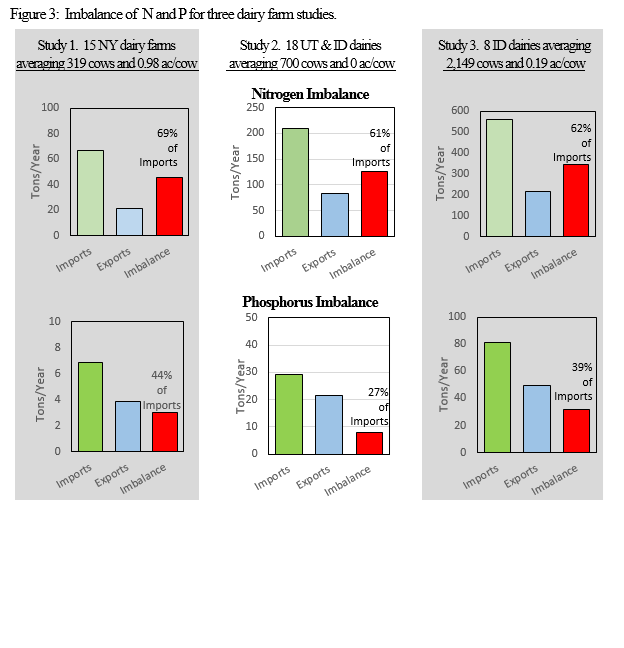Summary
This article is the second of a three-part summary of information shared at the Large Dairy Herd Management Conference held in Chicago in May 2-5, 2016. Part 1 introduced the concept of Whole Farm Nutrient Balance (WFNB). This article summarizes WFNB observed by three studies on dairies in New York, Idaho and Utah, and Idaho alone. The medium size NY dairies (see Figures 1, 2, and 3) have some similarities to many of our traditional Nebraska dairies. The two studies of Idaho and Utah dairies bear some similarities with some of Nebraska’s larger dairies.
Take home message from first article:
- A dairy farm’s environmental risk (due to nutrients) is measured by the imbalance between imported nitrogen and phosphorus (e.g. purchased feed) with nutrients exported off-farm in managed products (e.g. milk).

- A balance between imported and exported nutrients is a dairy’s environmental goal…lowest risk.
- Nutrients recycled within the farm such as home grown feed or manure do not add nutrients to the farm, only recycle nutrients. The more efficiently a dairy recycles nutrients, the less need there is for imported fertilizer and purchased feed.
- Traditional field based nutrient plans (using manure efficiently on cropland) reduces imported fertilizer but ignores the other three sources of imported nutrients.
Imports
Nutrients arrive on commercial dairies in four common forms, (see WFNB figure) but all studies point to purchased feed as the single largest source of imported N and P (Figure 1). As land base increases and more feed is grown by the dairy, imported N as legume fixed N and fertilizer N and P can become modestly important (up to 30% of imported N and 15% of imported P for the NY farms).
Take Home Messages:
- Purchased feed is the dominant source of imported nutrients on most dairy farms and possibly the largest factor driving a dairy’s environmental risk caused by nutrients.
- If an imbalance exist, then improved nutrient management should begin with a review of decisions impacting the size of imported feed N and P.
- Only if the dairy has significant land base will there be opportunities to apply traditional manure nutrient planning to reduce imported fertilizer. Traditional manure nutrient plans have little or no value for many dairies with a limited land base such as observed on the Idaho and Utah dairies (see Figure 1).
Exports
To avoid an accumulation of nutrients on a dairy, the goal is to export nutrients in managed products in similar quantities as those imported. A review of the three studies suggested that:
- Exported N and P is dominated by milk leaving the farm (43 to 92% of all exported nutrients). Often ignored, the efficiency of
 converting feed into milk is an important nutrient management strategy.
converting feed into milk is an important nutrient management strategy. - For farms with little or no land base, manure is an essential export. For the Utah dairies with no land base, it seems rather short-sighted to require a traditional field based nutrient management plan since there is no imported fertilizer to replace. These dairies must match the imported feed nutrients with the exported milk and manure nutrients to be environmentally sustainable.
- Results from WFNB planning on several hundred NY dairies has suggested that a dairy with at least 1 acre of land per animal unit (1000 lbs. of cows and heifers) is needed to efficiently managing manure nutrients within the farm. How, does your dairy’s land base to animal units compare?
Do Imports and Exports Balance?
An imbalance between nutrients imported and exported (as managed products) represents either a direct loss to the environment (e.g. nitrate into water) or a growing risk for future losses (e.g. increasing soil P levels). Nitrogen is a “leaky” nutrient and unavoidable N losses (and some level of imbalance) will occur even on well managed dairies. Phosphorus i s generally conserved suggested a balance between P imports and exports is an achievable goal.
s generally conserved suggested a balance between P imports and exports is an achievable goal.
In all three studies, the average N imbalance was between 60 and 70% of the imported N, suggesting that only one-third of the imported N is utilized and exported. Average P imbalance ranged from 27 to 44% of the imported P across the three studies. Individual authors reported significant variation among individual farms, suggesting that management decisions will influence the size of the imbalance.
Table 1. Whole farm imbalance when expressed on a per cow per year basis.
| Study | N Imbalance | P Imbance |
|---|---|---|
|
Study 1. 15 NY dairies averaging 319 cows |
290 lbs. N/cow 0.11 lb. N/gallon of milk |
19 lbs. P/cow 0.007 lb. P/gallon of milk |
|
Study 2. 18 UT and ID dairies averaging 700 cows |
360 lbs. N/cow 0.14 lb. N/gallon of milk |
22 lbs. P/cow 0.009 lb. P/gallon of milk |
|
Study 3. 8 ID dairies averaging 2,149 cows |
320 lbs. N/cow 0.12 lb. N/gallon of milk |
23 lbs. P/cow 0.009 lb. P/gallon of milk |
Table 1 provides some perspective for the N and P imbalance. For example, the N imbalance (most is lost to the environment) would suggest that these farms lose more than 0.1 lbs. of N into the environment for every gallon of milk the consumer buys, enough N to make 1200 gallons of water unsafe to drink. In reality, not all N is lost to water. Some of the N volatilizes as ammonia into the air. However, this is likely a statistic would cause consumers concern. Reducing N losses should be a priority.
P imbalance represents a growing environmental risk for a dairy. A rough rule of thumb of 8 to 9 lbs. of elemental P will raise 1 acre of soil by 1 ppm. For the NY dairies which averaged about 1 cow per acre, cropland on these farms would see an average 2 ppm increase in soil P levels annually. Applying the same assumptions to the 8 Idaho dairies with more than 5 cows per acre, one would expect an average soil P increase of about 15 ppm per year. The implications of a P imbalance are magnified for farms with a smaller land base. For the NY dairies, the slow increase in soil P levels gives some time for finding a solution to the P imbalance. That window of opportunity for the 8 Idaho dairies is much shorter.
From this discussion we have learned:
- Minimizing a whole farm nutrient imbalance is essential to minimizing a dairy’s environmental risk.
- Dairy farms commonly experience a whole farm nutrient imbalance, suggesting that an environmental risk is likely.
- Our traditional nutrient management plans focus on manure replacement of imported fertilizer. The benefit of these plans are not sufficient to address the size the imbalance on dairy farms. Nutrient plans that focus on reducing purchased feed or increasing exported manure have greater chance of success for many dairies.
The final article in this 3-part series will explore: 1) Is whole farm nutrient balance a concern for my farm? 2) What strategies will achieve a nutrient balance?